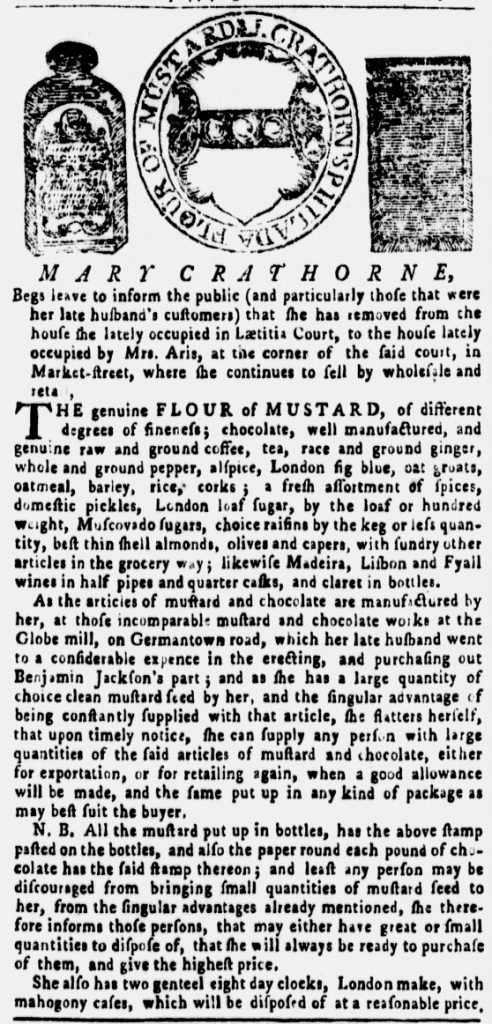What was advertised in a colonial American newspaper 250 years ago this week?

“All the mustard put up in bottles, has the above stamp pasted on the bottles.”
Readers of the Pennsylvania Gazette would have been familiar with the “genuine FLOUR of MUSTARD” and chocolate that Mary Crathorne advertised in February 1768. Her husband, the late Jonathan Crathorne, had previously produced and sold chocolate and mustard with Benjamin Jackson, but when that partnership dissolved the two men each continued in the business. Sometimes their advertisements appeared one after the other in the Pennsylvania Gazette, as was the case in the November 21, 1765, edition.
Jonathan Crathorne’s advertisement included the same woodcut that his wife later used to promote the business that she operated after his death. It featured a seal flanked by a bottle of mustard on the left and a brick of chocolate on the right. The seal incorporated William Penn’s insignia, a shield decorated with three silver balls, but it bore the words “J. CRATHORN’S PHILADA FLOUR OF MUSTARD.” Crathorne associated pride in the colony with his own products.
After they parted ways, Jonathan Crathorne and Benjamin Jackson engaged in a prolonged public dispute in their advertisements. Mary Crathorne was not as aggressive as her husband in that regard, but the widow did not that “her late husband went to a considerable expence in the erecting, and purchasing out Benjamin Jackson’s part” of “those incomparable mustard and chocolate works at the Globe mill, on Germantown road.”
Mary Crathorne did not want her product confused for any other. To that end, the woodcut in her newspaper advertisement had a purpose that went beyond drawing the attention of readers. “All the mustard put up in bottles,” she reported, “has the above stamp placed on the bottles.” Similarly, “the paper round each pound of chocolate has the same stamp thereon.” To avoid competitors’ products being mistaken for her mustard and chocolate, the widow Crathorne deployed the woodcut from her advertisements as a brand to mark her merchandise. Her husband may have followed the same practice, but his advertisements did not explicitly state that was the case. Perhaps as a woman running a business in a marketplace dominated by men Mary Crathorne found it necessary to devise additional means of promoting her products. She made it easy for consumers to recognize her mustard and chocolate by making sure they were labeled with some sort of trademark that identified the producer.
